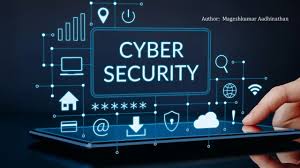
Introduction:
“Understanding Cybersecurity: How to Stay Safe Online” is crucial in today’s digital world, where almost everything we do is connected to the internet. Cybersecurity refers to the practices, technologies, and strategies designed to protect our data, devices, and networks from cyber threats. With rising cases of hacking, identity theft, and online fraud, it’s more important than ever to learn how to protect your personal information. Simple measures, like using strong passwords and keeping software up to date, can significantly reduce your risk. Cybersecurity also involves being aware of common threats like phishing scams and malware. Educating yourself on online safety best practices can help you navigate the digital world with confidence. By staying informed and taking proactive steps, you can safeguard your online presence from malicious attacks.
What is Cybersecurity?
Cybersecurity is the practice of protecting computers, networks, programs, and data from digital attacks, unauthorized access, damage, or theft. It involves using a combination of technologies, processes, and best practices to defend against various online threats, such as hacking, malware, and phishing. Cybersecurity aims to ensure the confidentiality, integrity, and availability of information, preventing it from being accessed or altered by malicious individuals. It covers everything from securing personal devices and home networks to protecting sensitive data in organizations and large enterprises. With cyber threats constantly evolving, cybersecurity is an ongoing process that requires constant updates and vigilance.
Common Cyber Threats:
Common cyber threats are increasingly sophisticated and pose significant risks to both individuals and organizations. Phishing attacks trick users into disclosing sensitive information, often by impersonating trusted entities. Malware, including viruses and spyware, can infect systems, steal data, or cause disruptions. Ransomware is a particularly dangerous form of malware that locks or encrypts files, demanding payment for their release. Man-in-the-middle (MITM) attacks allow cybercriminals to intercept communications and manipulate data. Denial of Service (DoS) attacks flood servers with excessive traffic, rendering them unusable. SQL injection exploits vulnerabilities in databases, allowing attackers to access or corrupt sensitive data. Social engineering manipulates individuals into revealing confidential information, bypassing technical defenses.
1. Malware:
Malware, or malicious software, includes viruses, worms, trojans, and spyware. These malicious programs can damage or disable computers, steal sensitive information, and spread to other devices.
2. Phishing:
Phishing attacks involve deceptive emails or websites that trick users into divulging personal information, such as passwords and credit card numbers. These attacks often appear as legitimate communications from trusted sources.
3. Ransomware:
Ransomware is a type of malware that encrypts a victim’s files. The attacker then demands a ransom payment to restore access to the data. This can lead to significant financial loss and operational disruptions.
4. Man-in-the-Middle Attacks:
In these attacks, cybercriminals intercept and possibly alter the communication between two parties without their knowledge. This can occur through unsecured Wi-Fi networks or compromised email accounts.
5. Denial-of-Service (DoS) Attacks:
DoS attacks aim to overwhelm a system, network, or website with traffic, rendering it unavailable to users. These attacks can disrupt business operations and services.
Protecting Personal Information Online:
Protecting personal information online is essential to safeguarding your privacy and security. One of the best ways to start is by using strong, unique passwords for each of your accounts, and enabling two-factor authentication (2FA) wherever possible. Be cautious about sharing personal details on social media or unfamiliar websites, as cybercriminals often use this information for identity theft. Regularly update your software, including operating systems and apps, to protect against vulnerabilities. Use a secure internet connection, such as a VPN, when accessing sensitive information, especially on public Wi-Fi. Install reputable antivirus software to detect and block malicious activities. Finally, stay informed about online threats, and be skeptical of suspicious emails or links that could be phishing attempts.
1. Manage Privacy Settings:
Review and adjust the privacy settings on social media platforms and other online services. Limit the amount of personal information you share publicly.
2. Be Mindful of What You Share:
Think twice before posting personal details online. Information such as your home address, phone number, and travel plans can be exploited by cybercriminals.
3. Use Encrypted Communication:
Whenever possible, use encrypted communication tools. Encryption ensures that even if data is intercepted, it cannot be read without the decryption key.
4. Monitor Your Financial Accounts:
Regularly check your bank and credit card statements for unauthorized transactions. Set up alerts to notify you of any suspicious activity.
Future Trends in Cybersecurity:
The future of cybersecurity is shaped by emerging technologies and evolving threats, leading to new strategies for protection. Artificial intelligence (AI) and machine learning will play a bigger role in detecting and responding to cyberattacks faster and more effectively. As more devices become interconnected through the Internet of Things (IoT), securing these devices will become a major focus. Blockchain technology is also expected to enhance data security and transparency in transactions. Cybersecurity will shift towards a more proactive approach, with predictive analytics helping to anticipate and prevent attacks before they happen. With the rise of remote work, securing cloud infrastructure and remote access will be a top priority. Lastly, the increasing sophistication of cyber threats will drive the demand for highly skilled cybersecurity professionals, creating new career opportunities in the field.
1. Artificial Intelligence and Machine Learning:
AI and machine learning are increasingly being used to enhance cybersecurity. These technologies can analyze vast amounts of data to identify patterns and detect anomalies that may indicate a cyber threat.
2. Blockchain Technology:
Blockchain offers a decentralized and secure method of recording transactions. Its applications in cybersecurity include securing data integrity and preventing unauthorized access.
3. Quantum Computing:
While quantum computing poses potential risks to current encryption methods, it also offers opportunities for developing more secure encryption techniques. Researchers are exploring ways to leverage quantum computing for enhanced cybersecurity.
4. Internet of Things (IoT) Security
With the proliferation of IoT devices, securing these devices has become a priority. Ensuring that IoT devices are secure by design and regularly updated is essential for preventing cyber attacks.
Also Read: Social Media Advertising
